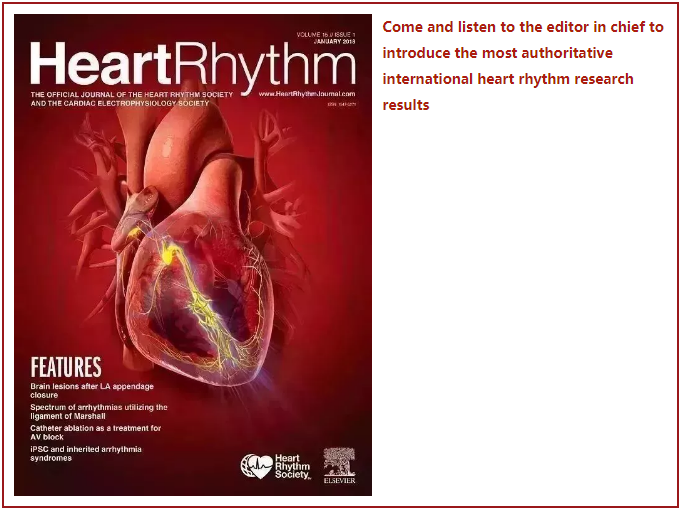HeartRhythm主编—陈鹏生教授语音速递(一月刊 英文版)
<< First issue in January 2022 >>


Peng-Sheng Chen
Hello, this is Dr. Peng-Sheng Chen, the Editor-in-Chief of Heart Rhythm. The January 2022 issue is a devoted to clinical trials.
The first article is titled “Clinical Outcomes Of Left Bundle Branch Area Pacing Compared To Right Ventricular Pacing: Results From The GeisingerRush Conduction System Pacing Registry”. The purpose of this study was to compare clinical outcomes between LBBAP and RVP among patients undergoing pacemaker implantation. The primary composite outcome included all-cause mortality, heart failure hospitalization, or upgrade to biventricular pacing. The authors studied 703 patients. They found that LBBAP resulted in improved clinical outcomes compared to RVP. Higher burden of ventricular pacing was the primary driver of these outcome differences.
The next article is “Left bundle branch-optimized cardiac resynchronization therapy (LOTCRT): results from an international LBBAP collaborative study group”. The authors aimed to assess the feasibility and outcomes of CRT based on LBBAP combined with coronary venous left ventricular pacing in an international multicenter study. LOT-CRT was successful in 91 of 112 patients (81%). At follow-up of ≥3 months, the ejection fraction improved to 37% ± 12% and clinical improvement was noted in 76% of patients. The authors conclude that LOT-CRT is feasible and safe and provides greater electrical resynchronization as compared with BiV-CRT and could be an alternative, especially when only suboptimal electrical resynchronization is obtained with BiV-CRT.
Up next is “Leadless LV Stimulation with WiSE-CRT System-Initial Experience and Results from Phase I of SOLVE-CRT Study”. WiSE-CRT is a wireless LV endocardial pacing system, and delivers ultrasonic energy to an LV electrode. The purpose of this study was to present short-term outcomes with the WiSE-CRT system in 19 centers with no prior implanting experience. The authors demonstrated a high success rate of LV endocardial electrode placement in centers with no prior implanting experience. Favorable clinical responses in heart failure symptoms and significant LV reverse remodeling were noted.
Coming up next is “Sinus Node Sparing Hybrid Thoracoscopic Ablation Outcomes in Patients with Inappropriate Sinus Tachycardia (SUSRUTA-IST Registry)”. This is a multicenter prospective registry comparing the sinus node sparing hybrid ablation strategy with RF sinus node ablation modification. The hybrid procedure was performed using an RF bipolar clamp, isolating superior vena cava/inferior vena cava with the creation of a lateral line across the crista terminalis while sparing the sinus node region identified by endocardial 3-dimensional mapping. RF-SN modification was performed by endocardial and/or epicardial mapping and ablation at the site of earliest atrial activation. The authors studied 100 patients. They found that the novel sinus node sparing hybrid ablation procedure appears to be more efficacious and safer in patients with symptomatic drug-resistant idiopathic sinus tachycardia with long-term durability than RF-sinus node ablation.
Next article is “Use of Oral Contraceptives in Women with Congenital Long QT Syndrome”. The safety of oral contraceptives use by sex hormone content has not been assessed in women with LQTS. The authors studied 1659 women with LQTS including 370 (22%) treated with an oral contraceptive. They found that progestin-only oral contraceptives were associated with a pronounced 2.8-fold increased risk of cardiac events in women who did not receive β-blocker therapy, while β-blockers were highly protective during progestin-only oral contraceptives treatment. The risk associated with oral contraceptives use without concomitant β-blocker treatment was pronounced in women with LQTS type 2. The authors conclude that progestinonly oral contraceptives should not be administered in women with LQTS without concomitant β-blocker therapy. Oral contraceptives should be used with caution in women with LQTS type 2.
The above clinical trial articles are followed by regular articles. The first one is “Novel Aggregated Multi-Position Non-Contact Mapping of Atrial Tachycardia in Humans: From Computational Modelling to Clinical Validation”. A novel aggregated multiposition noncontact mapping (AMP-NCM) algorithm is proposed to diagnose cardiac arrhythmias. The purpose of this study was to computationally determine an accuracy threshold and to compare the accuracy and clinical utility of AMP-NCM to gold standard contact mapping. In a prospective cohort of patients with atrial tachycardia, noncontact mapping recordings from a single position and multiple positions were compared to contact mapping with a high-density multipolar catheter using morphology and timing differences of reconstructed signals. The authors found that once 60 catheter positions were achieved, AMP-NCM successfully diagnosed mechanisms of atrial tachycardia and identified treatment sites equal to gold standard contact mapping in 3 minutes of procedural time.
Up next is “Role of subcutaneous Implantable Loop Recorder for the diagnosis of arrhythmias in Brugada Syndrome: a single center experience”. Of 415 BrS patients recruited consecutively, 50 (12%) received an ILR (58% male). Thirty-one (62%) had experienced syncopal or presyncopal episodes, and 23 (46%) had palpitations. During median follow-up of 28 months (range 1-68), actionable events were detected in 11 subjects (22%); 7 had recurrences of syncope/presyncope, with 4 showing defects in sinus node function or atrioventricular conduction. The authors conclude that continuous ILR monitoring yielded a diagnosis of tachy- or bradyarrhythmic episodes in 22% of cases. Recurrences of syncope were associated with bradyarrhythmic events. Use of ILR can be helpful in guiding the management of low-/intermediate-risk BrS patients and ascertaining the cause of unexplained syncope.
Up next is “Role of chronic continuous intravenous lidocaine in the clinical management of patients with malignant type 3 long QT syndrome”. The authors performed a retrospective review of patients evaluated and treated at Mayo Clinic and identified 4 of 161 patients with LQT3 (2.5%) who were refractory to standard therapies and therefore treated with IV lidocaine. The median age at first IV lidocaine infusion was 2 months, and the median cumulative duration on IV lidocaine was 11.5 months. In all patients, lidocaine infusion resulted in a significant reduction of LQT3-triggered cardiac events. The authors conclude that for patients with LQT3 who are refractory to standard treatment, chronic IV lidocaine infusion can be used as a potential "bridge to transplant."
Up next is “Ventricular Arrhythmias in Athletes: Role of a Comprehensive Diagnostic Workup“. The authors evaluated 227 consecutive athletes after being disqualified from participating in sports because of ventricular arrhythmias. After noninvasive tests, electrophysiological study, electroanatomic mapping or CMR-guided electroanatomic mapping was performed, following a prespecified protocol. A diagnosis of heart disease could be formulated in 30 to 45% of the study population. In the subset of athletes undergoing electroanatomic mapping, invasive diagnostic workup allowed diagnostic reclassification of half of the athletes. The authors conclude that a comprehensive invasive workup provided additional diagnostic elements and could improve the sports eligibility assessment of athletes presenting with VAs. The extensive invasive evaluation presented could be especially helpful when noninvasive tests show unclear findings.
The next paper is “Impact of electrode size and spacing on electrograms: Optimal electrode configuration for near-field electrogram characterization”. This study included 8 sheep in which probes with different electrode size and interelectrode spacing were epicardially placed on healthy, fatty, and lesion tissues for measurements. As indices of capability in gap detection and far-field reduction, in different electrode sizes (0.1 mm/0.2 mm/0.5 mm) and 4 interelectrode spacing (0.1 mm/0.2 mm/0.3 mm/0.5 mm/3 mm) and the optimized electrode size and interelectrode spacing were determined. The authors found that electrode size affects both unipolar and bipolar EGMs. Catheters with microelectrodes and very small interelectrode spacing may be superior in gap detection and far-field reduction. Importantly, this electrode configuration could dramatically reduce artifactual complex fractionated atrial electrograms and may open a new era for AF mapping.
Up next is “Right predominant electrical remodeling in a pure model of pulmonary hypertension promotes reentrant arrhythmias”. The model is the Sprague-Dawley rats with left pneumonectomy followed by injection of the vascular endothelial growth factor inhibitor. These rats exhibited RV hypertrophy and were highly prone to pacing-induced VT/VF. In this pure model of pulmonary arterial hypertension, the authors document RV-predominant remodeling that promotes multiwavelet reentry underlying VT. The model represents a severe form of pulmonary arterial hypertension that allows the study of EP properties without the confounding influence of extrapulmonary toxicity.
The next article is “Successful continuous positive airway pressure treatment reduces skin sympathetic nerve activity in patients with obstructive sleep apnea”. The authors recorded skin sympathetic nerve activity from 9 patients with OSA before and immediately after CPAP therapy. They found that OSA episodes were more frequently associated with the very low or low frequency oscillations of skin sympathetic nerve activity (SKNA). Compared with baseline, CPAP significantly decreased the arousal index and AHI and increased the minimal and mean oxyhemoglobin levels. Optimal treatment significantly increased the dominant frequency and reduced the heart rate, average SKNA, SKNA burst duration, and total burst area. The dominant frequency negatively correlated with aSKNA. The authors conclude that VLF, LF, and HF oscillations are observed in human SKNA recordings. Among them, VLF and LF oscillations are associated with OSA while HF oscillations are associated with normal breathing. CPAP therapy reduces aSKNA and shifts the frequency of SKNA oscillation from VLF or LF to HF.
The next article is a research letter titled “Effects of COVID-19 Pandemic on Physical Activity in Children and Young Adults with Implanted Devices”. Using device-based activity data, the authors found that children and young adults with implanted cardiac devices experienced a significant decline in physical activity during a government-mandated COVID-19 stay-at-home order compared with the same period in 2019.
The above original articles are followed by two contemporary reviews titled “Structure and Function of the Ventricular Tachycardia Isthmus” and “Interpreting Device Diagnostics for Lead Failure”.
I hope you enjoyed this podcast. For Heart Rhythm, I’m the Editor-In-Chief, Dr. Peng-Sheng Chen.











